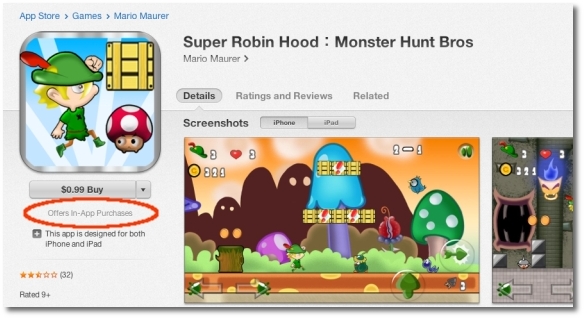The App Store’s in-app purchasing system is a cash cow, but it’s also a huge pain in the neck for Apple, and for the rest of us. The company has begun tutoring customers on the subject, but continues to approve applications that make improper use of the system.
Apple this week released a guide on its App Store aiming to raise awareness about in-app purchases: what they are, the various types of IAPs out there, how they work, etc.
“Many free and paid apps offer In-App Purchases - optional transactions designed to augment an app’s functionality,” the tutorial states. On paper, the system sounds extremely beneficial for all parties involved.
- users can add an extra something at any time in exchange for a small sum; - developers get an additional stream of revenue, or a way to cash in on a free app; - apple gets a 30 percent cut with every transaction and keeps the App Store well fed.
In reality, in-app purchases are causing a lot of dismay. The Mario clone we discussed earlier today is a perfect example of this scenario. And there are countless others we could mention.
We remember a time when Apple took great pride in rejecting apps that went afoul of its guidelines.

Apple continues with the IAP guide, stating “You can only make In-App Purchases from an app that you’ve already downloaded. To find out if an app offers In-App Purchases, refer to the app’s product page, near the Buy or Free button,” says the tutorial.
We included the screenshot above to show you what the notice looks like (highlighted in red).
You can tell Apple is having a lot of trouble with the IAP system by simply flipping through the reviews on iTunes. Here’s an example: Super Robin Hood: Monster Hunt Bros (with a relevant screenshot below).

Apple may pull this app if it finds that it goes against the App Store's rules and regulations, so don’t be surprised if the link no longer works after we run this story.
The Cupertino giant has been forced to make a lot of adjustments to clarify what in-app purchases are and what they do. The aforementioned indicator next to the Free/Buy button is just one of them. Apple has even had to pay thousands of pounds to a family whose kid tapped the Buy button one too many times. As much as the company would like to say that was a one-time affair, numerous identical scenarios have been reported.
Of course, it’s not Apple’s fault that Mom and Dad didn’t bother to restrict in-app purchases on their iPhone or iPad. As such, the Mac maker urges developers to highlight this option in the description of their app.
Apple also carefully outlines the types of in-app purchases that a customer may carry out.
“There are three types of In-App Purchases:
- permanent enhancements like unlocking game levels, removing advertising, or expanding an app’s feature set; - expendable purchases, such as extra lives for a game character; - and auto-renewing subscriptions (such as a monthly magazine that charges every 30 days).”
The simple fact that Apple needs to take all these precautions and still has problems with in-app purchases raises an important question: is the IAP system ultimately beneficial for the company and its customers? After all, these issues are starting to give the App Store a bad rep.
Looking back to the time when the App Store debuted, we fear that Apple made an ill-fated decision to reject traditional demos and free trials. The App Store used to be a curated place filled with premium apps. As it approaches one billion IPs, the venue these days is packed to the brim with titles that trick you into buying content that should otherwise be free, while Apple's very own review team has chosen a very unfortunate time to slack off.

 14 DAY TRIAL //
14 DAY TRIAL //